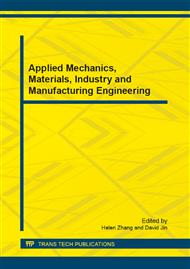[1]
Laird P., etc., Ferrofluid-based deformable mirrors: A new approach to AO using liquid mirrors, In Proceedings of SPIE Volume 4839, Adaptive Optical System Technologies II, Edited by Peter L. Wizinowich and Domenico Bonaccini, SPIE - The International Society of Optical Engineering, (2003).
DOI: 10.1117/12.459065
Google Scholar
[2]
Brousseau D., Borra E. F., Rochette M. and Landry D. B., Linearization of the response of a 91-actuator magnetic liquid deformable mirror, Optics Express, vol. 18, no. 8, pp.8239-8250, (2010).
DOI: 10.1364/oe.18.008239
Google Scholar
[3]
Brousseau D., Borra E. F., Ruel H. J., and Parent J., A magnetic liquid deformable mirror for high stroke and low order axially symmetrical aberrations, Optics Express, vol. 14, pp.11486-11493, (2006).
DOI: 10.1364/oe.14.011486
Google Scholar
[4]
Borra E. F., Liquid Mirrors in Engineering, Optics & Photonics News, pp.14-17, September (2009).
Google Scholar
[5]
Iqbal A. and Ben Amara F., Modeling and experimental evaluation of a circular magnetic-fluid deformable mirror, International Journal of Optomechatronics, vol. 2, no. 2, p.126–143, (2008).
DOI: 10.1080/15599610802081803
Google Scholar
[6]
Iqbal A., Wu Z. and Ben Amara F., Closed-loop control of magnetic fluid deformable mirrors, Optics Express, vol. 17, no. 21, pp.18957-18970, (2009).
DOI: 10.1364/oe.17.018957
Google Scholar
[7]
Wu Z., Azhar I. and Ben Amara F., LMI-based multivariable PID controller design and its application to the control of the surface shape of magnetic fluid deformable mirrors, IEEE Transaction on Control System Technology, vol. 19, no. 4, pp.717-729, (2011).
DOI: 10.1109/tcst.2010.2055566
Google Scholar
[8]
Zahn M., Magnetic fluid and nanoparticle applications to nanotechnology, Journal of Nanoparticle Research, vol. 3, pp.73-78, (2001).
Google Scholar
[9]
Nakano M., etc., Drug delivery system using nano-magnetic fluid, ICICIC '08, 3rd International Conference on Innovative Computing Information and Control, p.338, June 18-20, (2008).
Google Scholar
[10]
Dery J. P., Borra E. F., and Ritcey A. M., Ethylene glycol based ferrofluid for the fabrication of magnetically deformable liquid mirrors, Chemistry of Materials, vol. 20, no. 20, pp.6420-6426, (2008).
DOI: 10.1021/cm801075u
Google Scholar


